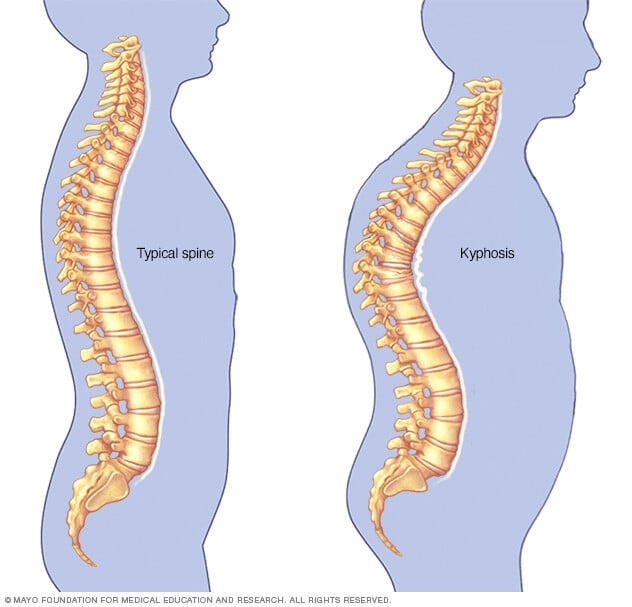Kyphosis
Overview

Kyphosis is an excessive forward rounding of the upper back.
In older people, kyphosis is often due to weakness in the spinal bones that causes them to compress or crack. Other types of kyphosis can appear in infants or teens. These types are due to malformation of the spine or wedging of the spinal bones over time.
Mild kyphosis causes few problems. Serious kyphosis can cause pain and be disfiguring. Treatment for kyphosis depends on your age, and the cause and seriousness of the curvature.
Symptoms
Mild kyphosis may not have any noticeable symptoms. In fact, the upper back naturally has a little kyphosis. People who have excessive curvature may experience back pain and stiffness.
When to see a doctor
Make an appointment with your healthcare professional if you notice an increased curve in your upper back or in your child's spine.
Causes
The bones that make up a healthy spine look like cylinders stacked in a column. These bones are called vertebrae. Kyphosis happens when the vertebrae in the back become more wedge shaped.
The shape of vertebrae can be changed by:
- Fractures. Broken vertebrae can result in curvature of the spine. Compression fractures, which can happen in weakened bone, are the most common. Mild compression fractures may not produce noticeable symptoms.
- Osteoporosis. Weak bones can cause spinal curvature, especially if weakened vertebrae develop compression fractures. Osteoporosis is most common in older women and people who have taken corticosteroids for long periods of time.
- Disk degeneration. Soft, circular disks act as cushions between spinal vertebrae. With age, these disks flatten and shrink, which often worsens kyphosis.
- Scheuermann's disease. Also called Scheuermann's kyphosis, this disease usually becomes noticeable during adolescence.
- Other problems. Spinal bones that don't develop properly before birth can cause kyphosis. Kyphosis in children also can be associated with certain medical conditions.
Risk factors
The risk of developing kyphosis as an adult increases with age as bone density decreases and spinal disks degenerate. In children, certain genetic and metabolic conditions may put them at increased risk for kyphosis, including osteogenesis imperfecta, Ehlers-Danlos syndrome and Marfan syndrome.
Complications
In addition to causing back pain, kyphosis may cause:
- Limited physical functions. Kyphosis is associated with weakened back muscles and difficulty doing tasks such as walking and getting out of chairs. The spinal curvature can also make it difficult to gaze upward or drive and can cause pain when you lie down.
- Digestive problems. Serious kyphosis can compress the digestive tract, causing problems such as acid reflux and difficulty with swallowing.
- Back pain. Some patients with serious kyphosis experience back pain.
- Body image problems. People with kyphosis, especially adolescents, may have poor body image from having a rounded back.
Diagnosis
Your healthcare professional will generally conduct a thorough physical exam. You may be asked to bend forward from the waist to allow your healthcare professional to view your spine from the side. You also may undergo a neurological exam to check your reflexes and muscle strength.
Tests that may be ordered include:
- X-rays or CT scans. X-rays can determine the degree of curvature and detect deformities of the vertebrae. A CT scan might be recommended if your healthcare professional needs more detailed imaging.
- MRI. Using a strong magnetic field, MRIs can detect a recent fracture in your spine.
- Nerve tests. If you are experiencing numbness or muscle weakness, you may need tests to determine how well nerve impulses are traveling between your spinal cord and your extremities.
- Bone density tests. Low-density bone can increase the risk for compression fractures and often can be improved with medicines.
Treatment
Kyphosis treatment depends on the cause and seriousness of your condition.
Medicines
Kyphosis treatment may include:
- Pain relievers. If medicines available without a prescription — such as acetaminophen (Tylenol, others), ibuprofen (Advil, Motrin IB, others) or naproxen sodium (Aleve) — aren't enough, stronger pain medicines are available by prescription.
- Osteoporosis medicines. Certain medicines may help strengthen your vertebrae and prevent additional spinal fractures that could worsen your kyphosis.
Therapy
Certain types of kyphosis may be helped by:
- Exercises. Stretching and strengthening exercises may help improve spinal flexibility and relieve back pain.
- Bracing. Children who have Scheuermann's disease may be able to slow the progression of kyphosis by wearing a spine brace while they are in a rapid growth spurt.
Surgical and other procedures
Severe kyphosis can result in symptoms. Rarely, severe kyphosis can pinch the spinal cord or nerves. This is more common with congenital kyphosis or kyphosis that can occur after previous surgeries.
To correct the kyphosis, surgery may be needed. The most common procedure is spinal fusion. In this procedure, the surgeon uses metal rods and screws to fasten the spinal bones together in the correct position.
Compression fractures are usually treated without surgery.
Preparing for an appointment
You may be referred to a doctor who specializes in the diagnosis and treatment of spine disorders.
What you can do
- Be aware of any pre-appointment restrictions, such as restricting your diet.
- Write down your symptoms, including any that may seem unrelated to the reason you scheduled the appointment.
- Make a list of medicines, vitamins and supplements you're taking.
- Write down your key medical information, including other conditions.
- Write down key personal information, including any recent changes or stressors in your life.
- Write down questions to ask your healthcare team.
- Ask a relative or friend to accompany you to help you remember the information you're given.
Questions to ask your doctor
- What tests do I need? Is there any special preparation for them?
- Will I need treatment? What are my options, and what are the benefits and risks of each?
- I have other health problems. How can I best manage these conditions together?
In addition to the questions you've prepared to ask your care team, don't hesitate to ask other questions that occur to you during your appointment.
What to expect from your doctor
Your healthcare professional is likely to ask you a number of questions. Being ready to answer them may leave time to go over other points in greater detail. You may be asked:
- When did you begin experiencing symptoms? How serious are they?
- Have your symptoms been continuous or occasional?
- What, if anything, seems to improve or worsen your symptoms?



